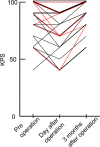Tumor resection in paramedian structures of the frontal lobe poses a risk for corpus callosum infarction
- PMID: 40358745
- PMCID: PMC12075285
- DOI: 10.1007/s00701-025-06555-y
Tumor resection in paramedian structures of the frontal lobe poses a risk for corpus callosum infarction
Abstract
Purpose: Surgeons resecting intraparenchymal tumors should be aware of potential white matter ischemia resulting from damage to the medullary artery arising from the cerebral cortex. In the vicinity of the paramedian structure, crucial brain regions for higher brain function such as corpus callosum and cingulate cortex are located. However, the actual area of ischemia induced by damaging the medullary artery supplying the paramedian structures is not known. The present study investigated the ischemic field following tumor resection in paramedian structures of the frontal lobe.
Methods: Patients having intraparenchymal tumors with lesions in the paramedian structures of the frontal lobe (superior frontal gyrus or cingulate gyrus) resected between April 2016 and June 2022 at Tohoku University Hospital were included in the study. Magnetic resonance images obtained within 72 h after surgery were used to retrospectively examine the extent of the resection and the distribution of ischemic complications. Related postoperative clinical symptoms were assessed using medical records.
Results: Thirty-three cases matched the inclusion criteria. The median age was 48 years. Cases comprised patients with an astrocytoma IDH-mutant (n = 11), oligodendroglioma IDH-mutant, and 1p/19q-codeletion (n = 12), and glioblastoma IDH-wildtype (n = 10). The main locations were superior frontal gyrus only (n = 17), cingulate gyrus only (n = 8), and both the frontal lobe and cingulate gyrus (n = 8). The cingulate gyrus was removed in 19 cases. In 16 of the 19 cases, ischemic foci were observed in the adjacent corpus callosum. In the 14 cases in which the cingulate gyrus was not removed, no ischemic foci appeared in the corpus callosum. Three cases exhibited a prolonged disturbance of consciousness after the second postoperative day, all with corpus callosum infarction.
Conclusion: Surgeons resecting intraparenchymal tumors in the paramedian structures of the frontal lobe, especially the cingulate gyrus, should be aware of the potential for ischemia foci emerging in the corpus callosum.
Keywords: Cingulate gyrus; Corpus callosum; Disconnection syndrome; Surgery.
© 2025. The Author(s).
Conflict of interest statement
Declarations. Ethics approval: This was approved by the Institutional Review Board Committee of Tohoku University Hospital (2023–1-416). Consent to participate and to publish: NA (Participants were given the option to opt out of this study). Conflict of interest: The authors declare no competing interests.
Figures







References
-
- Akashi T, Takahashi S, Mugikura S, Sato S, Murata T, Umetsu A, Takase K (2017) Ischemic white matter lesions associated with medullary arteries: classification of mri findings based on the anatomic arterial distributions. AJR Am J Roentgenol 209(3):W160–W168 - PubMed
-
- Degos JD, Gray F, Louarn F, Ansquer JC, Poirier J, Barbizet J (1987) Posterior callosal infarction. Clinicopathological correlations. Brain 110 ( Pt 5)(5):1155–1171 - PubMed
-
- Gomes FB, Dujovny M, Umansky F, Berman SK, Diaz FG, Ausman JI, Mirchandani HG, Ray WJ (1986) Microanatomy of the anterior cerebral artery. Surg Neurol 26(2):129–141 - PubMed
-
- Graham D, Tisdall MM, Gill D (2016) Corpus callosotomy outcomes in pediatric patients: A systematic review. Epilepsia 57(7):1053–1068 - PubMed
-
- Kahilogullari G, Comert A, Arslan M, Esmer AF, Tuccar E, Elhan A, Tubbs RS, Ugur HC (2008) Callosal branches of the anterior cerebral artery: an anatomical report. Clin Anat 21(5):383–388 - PubMed
MeSH terms
LinkOut - more resources
Full Text Sources
Medical
Miscellaneous

